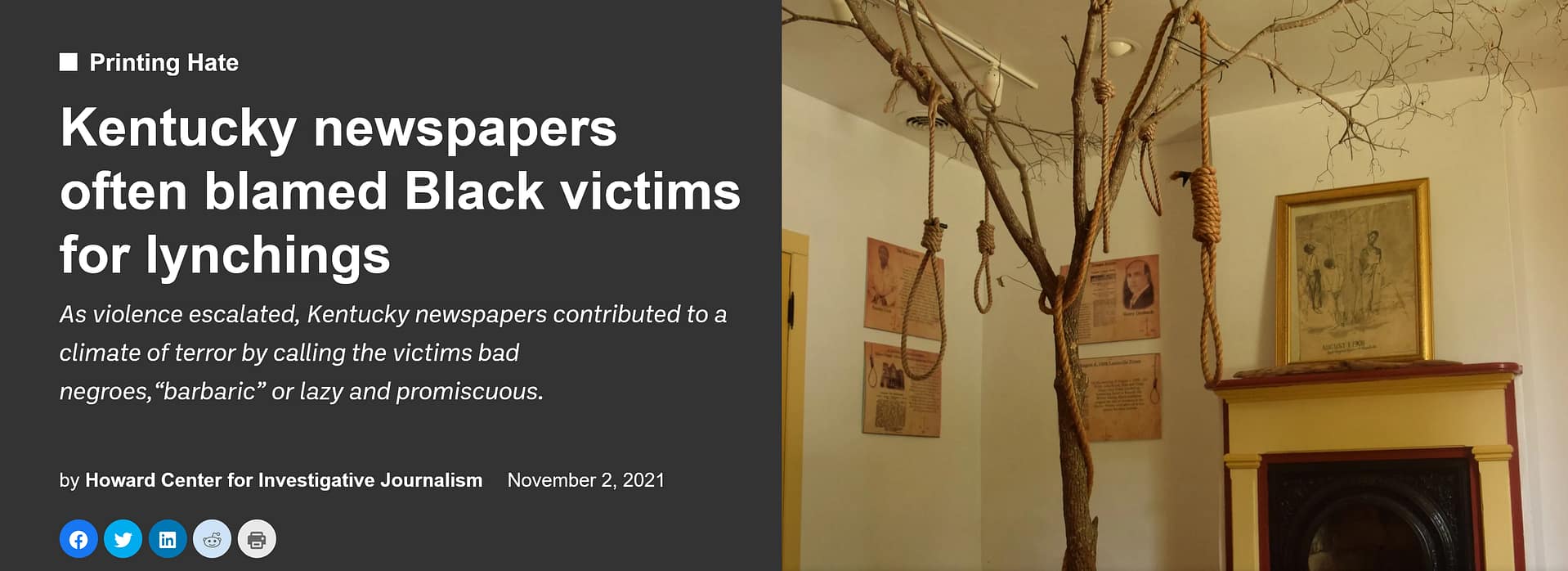

Vanessa Sanchez, writing for the Howard Center for Investigative Journalism, states that newspapers in Kentucky with predominantly white readerships blamed the victims of lynchings by using racial stereotypes in their reporting. See Sanchez’s full reporting on the issue here.
The materials within the collection provide insight into the lynchings of Virgil Jones, John Jones, Robert Boyer, and Joe Riley in the early morning of August 01, 1908. The group lynching was motivated by the death of James Cunningham, a farm overseer reported to be a leader of the local Ku Klux Klan Klaverns. The four were arrested on July 24,1908 and imprisoned in the jail of Russellville, Ky, on claims of supporting Rufus Browder’s shooting out of self-defense, which led to the death of Cunningham.
Based on Browder’s statements, he “went to work for Mr. Cunningham, about three months ago” after leaving his father’s farm. The individuals all worked as tenant farmers alongside one another and were members of the True Reformers, which met in local houses to conduct meetings before creating lodges. The True Reformers worked to promote self -sufficiency throughout the early 1900s. A relevant newspaper explaining statements made by Browder also states that it was a “society composed of negroes, which was organized for the purpose of providing insurance and burials. Further testimony from Browder included the following statements describing his relationship with the other men.
“One of them was serving a sentence for carrying a concealed weapon and the other three were awaiting trials on charges of the breach of the peace.” Joe Riley was convicted of carrying a concealed weapon. Boyer was convicted of breaching the peace and unlawfully assembling to interfere with the prosecution of Browder. John and Virgil Jones were also charged with breach of peace. Virgil Jones, approaching 20 years of age, and John Jones, born in 1869, are presumed to have been relatives, either as father and son or brothers, according to census records appearing in Louisville, Ky.
Aware of their location, an armed mob estimated between 50-100 men marched into the jail and demanded the four victims. The mob was believed to have been comprised of members from southwestern area of Russellville, in which Cunnigham had lived prior. They demanded the jailer, J.L. Butt, to hand over the keys which made their capture successful. The mob then marched each victim by force to the famous Proctor lynching tree located in the southwestern suburb of Logan Co and proceeded to lynch them. Their bodies were pinned with a note warning other African Americans to keep their distance and stop lodge meetings. Photographs of the lynching were taken and turned into postcards, which was a common occurrence. This quadruple lynching received federal attention and influenced the passing of federal law to condemn this practice.
References
- U.S. Census Bureau. Twelfth Census of the United States, 1900. “Schedule No. 1. – Population.” Jones, Virgil. AncestryLibrary Edition.
- “Lynched. Four Negroes Taken From Jail At Russelville and Hung By Mob,” The Big Sandy News, August 7, 1908. Chronicling America: Historic American Newspapers, Library of Congress.
- “Another Masked Mob Invades Russelville,” Hopkinsville Kentuckian, August 4, 1908. Newspapers.com.
- “Four Negroes Hung. By Russellville Mob-Taken From Jail and Lynched,” Daily Public Ledger, August 3, 1908. Newspapers.com.
- “Fifty white men, armed and masked, forced their way…” The Adair County News, August 12, 1908. Chronicling America: Historic American Newspapers, Library of Congress.
- “Another Blot Upon Civilization,” The Bee, August 6, 1908. Newspapers.com.
- “True Reformers were controversial in their day,” News-Democrat and Leader, October 3, 1997. Newspapers.com.
Note: The above links are simply citations for the home website from which the images have been drawn. Following these links may enhance the user’s experience, but it is not necessary. In order to further the long-term preservation of our site, all information in the above links can also be found in the above carousel of images.
Location of the Lynching
Citation
Briggs, Qwenton. “Robert Boyer; John Jones; Virgil Jones; and Joe Riley.” Documented Biographies. Documenting Racial Violence in Kentucky. February 16, 2022. https://drvk.createuky.net/biographies/robert-boyer-john-jones-virgil-jones-and-joe-riley/







